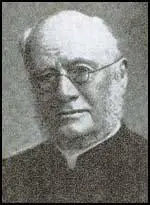William Benham

William Benham, the son of the village postmaster, was born in West Meon, near Petersfield, on 15th January 1831. He was trained as a teacher at St Mark's College in Chelsea.
Benham taught at the Blewcoat School, Westminster, but in 1856 he began attending lectures at King's College, London, where he was influence of Frederick Denison Maurice, the leader of the Christian Socialist movement. According to his biographer, Julian Lock, this "permanently affected his religious position in the direction of attempted engagement with intellectual trends outside the church, such as evolutionism."
Benham was ordained in 1857 and appointed divinity tutor and lecturer in English literature at St Mark's College under Derwent Coleridge. In 1864 he became editorial secretary to the Society for Promoting Christian Knowledge and professor of modern history at Queen's College, Harley Street.
Benham's preaching attracted the attention of Charles Longley, the Archbishop of Canterbury, who made him in 1867 the first vicar of the newly formed parish of Addington. Longley died in October 1868 but his replacement, Archibald Tait also valued the abilities of Benham and in 1872 he bestowed on him the important vicarage of Margate.
While the vicar of St John's the Baptist Church he met Ellen Ternan, the former mistress of Charles Dickens. Her biographer, Claire Tomalin : "Nelly's chief confidant, however, became - very properly, one might think - her local parish priest, the Vicar of St John's, the Revd William Benham. Benham was in his mid-forties when she met him, a jolly, kindly, dynamic man with literary tastes and a fluent pen, who had risen by his own talents from a humble background - a man, in fact, made in very much the same mould as Dickens and, as it happened, of the same age as Dickens when she first met him." Terman told him about her relationship with Dickens and that he had set her up in a house in Ampthill Square, where he visited her two or three times a week. She added that she came to feel remorse about the relationship and that she now "loathed the very thought of this intimacy".
Benham was appointed rector of St Edmund the King in Lombard Street in 1882. He later commented: "Our ritual is not very high. I moderated it as much as I could when I came there first, but continued what I felt able to fall in with, and so kept my congregation together". Although he came under attack for his non-traditional views, Archbishop Randall Davidson pointed out: "People might or might not agree with him in opinion. They could hardly fail, if they knew him well, to respect and even love him as a man."
In 1893 a well-known biographer, Thomas Wright, announced his attention of writing a new book on Charles Dickens and made a public request for letters from people who had received letters from the writer. George Augustus Sala wrote an article where he warned Wright that there were "circumstances connected with the later years of the illustrious novelist which should not and must not be revealed for fifty years to come at the very least". Eliza Lynn Linton joined in the debate by referring in her memoirs that Dickens had a mistress who "deceived, tricked and betrayed" him. Linton did not name the woman but it did cause a great deal of gossip about Dickens's love-life.
Georgina Hogarth became very concerned about the potential damage to Dickens' reputation and wrote to Wright asking him to abandon his plan. Wright agreed to do this but he still continued to collect information on Dickens. W. R. Hughes contacted Wright and said that he had letters from Dickens to a woman named Ellen Ternan. This was the first time he had heard the name and advised Hughes to burn them as they had probably been acquired dishonestly. One man who did respond to Wright was Benham who told him about Ellen's confession. Although he accepted that Benham's story was true, he decided against publishing his book about Dickens.
William Benham died at his home, 32 Finsbury Square, London, of heart failure on 30th July 1910, and was buried at Addington churchyard.
Primary Sources
(1) Claire Tomalin , The Invisible Woman (1990)
Nelly's chief confidant, however, became - very properly, one might think - her local parish priest, the Vicar of St John's, the Revd William Benham. Benham was in his mid-forties when she met him, a jolly, kindly, dynamic man with literary tastes and a fluent pen, who had risen by his own talents from a humble background - a man, in fact, made in very much the same mould as Dickens and, as it happened, of the same age as Dickens when she first met him.
(2) Peter Ackroyd , Dickens (1990)
We might consider that at least as a hypothesis, therefore - all the evidence about dickens's character, and all the evidence we possess about Ellen Ternan herself, suggest that the relationship between them acted for Dickens as the realisation of one of his most enduring fictional fantasies. That of sexless marriage with a young, idealised virgin.
It has generally been assumed, however, that their relationship was indeed consummated, and that Ellen Ternan became his mistress. The rumours were only given wide currency in the 1930s when a certain Thomas Wright passed on the remarks of a Canon Benham - to whom, it seems, Ellen "disburdened her mind" in later life in an apparently very generalised way.
